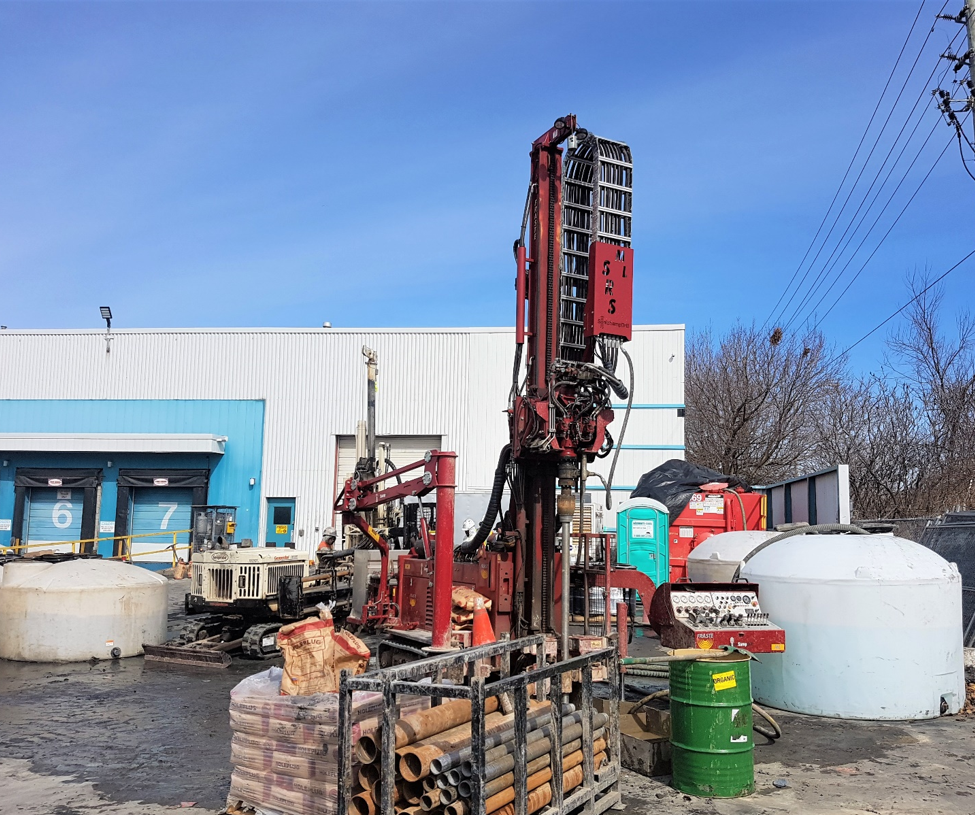There are many ways of remediating subsurface impacts at properties whether it be for due diligence purposes, or if pursuing a Record of Site Condition (RSC). The main factors at play are typically time and cost. If timing is the most pressing factor, the conventional dig-and-dump approach is often used. However, if there is no immediate time constraint an in-situ approach is often favourable because it is less intrusive, daily activities may not be interrupted, and it is often more cost effective. When considering an in-situ approach there are other obstacles to consider that are related to subsurface characteristics of the target treatment zone at the property.
This situation presented itself recently at an industrial property in the GTA that had chlorinated volatile organic compounds (cVOC) groundwater impacts. The groundwater impacts were present in what we called a ‘difficult aquifer’. More specifically, the depth to groundwater was approximately 10 m below ground surface within a tight (relatively impermeable) sandy/silt till. Premier completed a remedial options evaluation that identified in-situ injections of remedial amendments as the ideal approach to address the groundwater impacts. The difficulty however was how to deliver the remedial amendments to deeper depths into a tight soil (i.e., a difficult aquifer)?
There are three (3) conventional drilling/delivery techniques employed for remedial injection work which are described below:
- Permanent Injection Wells
- Good for sandy formations with injections under low pressure (<100 psi)
- Cannot be used when pressure requirements exceed 100 psi (i.e., blow-out the screen)
- Direct Push Temporary Injection Points
- Good for tighter shallow formations with injections under high pressure
- Cannot be used for deep overburden plumes (i.e., Geoprobe cannot advance the injection rods to depth without breaking equipment)
- Open Borehole Packer Injection
- Good for bedrock formations under low to high pressure
- Not applicable for some soil types as it relies on the borehole staying open
For our subject property the amendment selected required delivery of a particulate suspension that required high pressure (300-1000 psi) to a target treatment zone between 10 and 16 m bgs in a tight (soil type?) overburden. Based on these factors, none of the above conventional approaches were feasible.
Premier teamed up with a remediation contractor and completed pilot-tests at the subject property to find a suitable delivery approach. Through trial and error, the delivery method that ultimately met our objectives consisted of pre-drilling boreholes to depth with a Sonic drilling rig that can quickly drill through most overburden soils and cobbles. A casing was then inserted into the borehole and the hole was backfilled in 2’ lifts with a bentonite/grout mixture. The casing was pulled out of the hole as the 2’ lifts were placed until the borehole was backfilled to grade. Within 48 hrs, a Geoprobe drilling rig then advanced temporary rods vertically through the bentonite/grout backfilled hole and the amendments were injected horizontally out into the formation through the bentonite/grout backfill under an average pressure of approximately 500 psi. Field monitoring of adjacent monitoring wells showed a hydraulic influence and visuals of the injected amendments that allowed us to determine an expected radius of influence (ROI) for a full-scale application. Based on the results of these pilot tests, we are able to undertake a full-scale application using the design parameters obtained and successfully complete the remediation program on time and within the proposed budget.
The success of this ‘New Delivery Method’ provided Premier the opportunity to present our findings to other industry professionals at the 2019 Remediation Technologies Symposium in Banff, Alberta (October 2019) and the 2020 SMART Remediation conference in Toronto, Ontario (January 2020).
For more information on how Premier can assist you with your remediation objectives give us a call at 519-653-7140.
Gerren Feeney, P.Geo.
Premier Environmental Services Inc.






